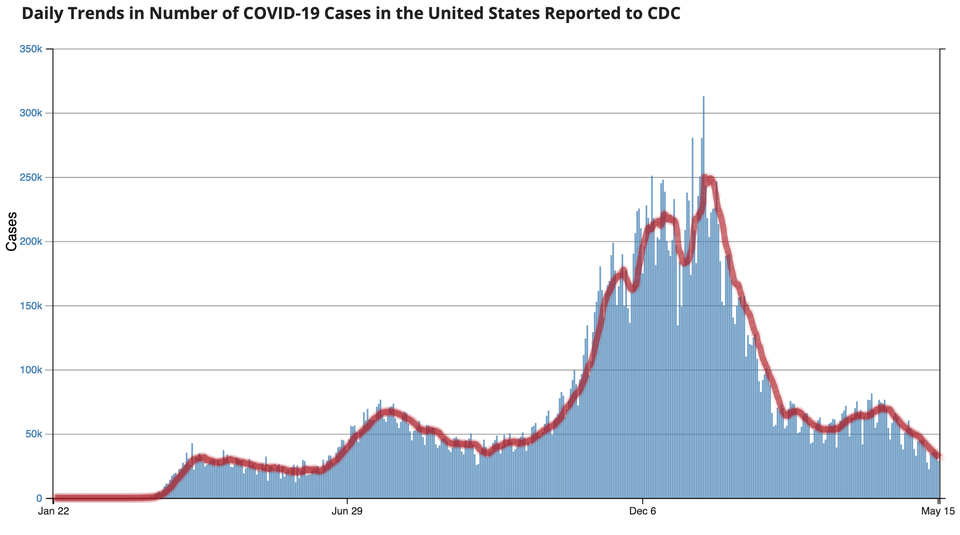In the midst of CDC mask guidance chaos, some GOOD NEWS:
⬇️ Cases in the U.S. are down 23.6% in the past week to 35,442 daily cases (7 day moving average).
⬇️ Cases are down 85.8% since the peak of 250,037 cases on January 8, 2021.
⬇️ New hospital admissions are down 13.6% from the previous week, and down 76.7% from the January peak.
⬇️ Daily deaths are down to 561, 10.5% lower than the previous week (7-day rolling averages).
❓Why are cases falling? As always, it’s complicated. The last year clearly taught us that humility is warranted when trying to explain the epidemic curve’s twists and turns.
(Read Nerdy Girl Jenn’s related take on the steep fall in cases in January.)
Most likely, we are seeing an impact of high levels of population immunity, both through vaccination and natural infection, combined with the benefits of continued prevention measures (while some may be acting as if the pandemic is over, many are still far from their pre-pandemic level of social contacts and behaviors).
THE STATS (As of May 17, 2021):
💥 37.1% of the US population is fully vaccinated.
💥 47.4% have received at least one dose.
There have been 32,722,464 confirmed cases in the US.
If we conservatively estimate there have been 3 times as many actual vs. confirmed infections, that represents close to 30% of the population with some natural immunity. If there are 4 times as many actual infections as confirmed infections, that would give us 40% of the population already infected.
Of course, these groups overlap, since many previously infected are also vaccinated. But combining these numbers it’s not unreasonable that we have 50-60+% of the population with at least partial immunity.
🛑 Each immune person acts as a fire break if they come in contact with an infected person, slowing transmission of the virus.
When transmission slows enough, we hit the magic tipping point of…. EXPONENTIAL DECAY! This is the moment when the horror of exponential math starts to work in our favor, with cases reducing by half rather than doubling over a certain period of time.
This is an exciting place to be, because once the Reproductive rate (Rt) is less than 1 (each infected person passing on the infection to less than one person on average), momentum is on our side. Continuing to build up population immunity through vaccination and maintaining basic precautions will *accelerate* this downhill slide in cases more than doing either one alone.
🙋♀ Does this mean we can’t see rising cases again? Unfortunately, no. While it will be harder to sustain a growing number of cases the more people are vaccinated, there are still millions of susceptible people, meaning outbreaks can and will occur—as seen recently in the highly vaccinated country of the Seychelles.
Population immunity is also not evenly spread across the country, with some states having much higher vaccination rates than others (ranging from 65.2% with at least one dose in Vermont to 32.5% in Mississippi). Since the benefits of herd immunity are localized (you need people around you to be immune and act as a fire break), local flare ups are likely to occur until we reach much higher levels of vaccination.
BOTTOM LINE:
💥 Cases are falling in the U.S. to levels not seen in many, many months…THIS IS REALLY GOOD NEWS.
💥 Momentum is on our side… because EXPONENTIAL DECAY!
💥 It is NOT over. Cases can still rise again until we reach much higher levels of vaccinations.
💥 Vaccinations & prevention measures (including masks) work *together* to accelerate declines in cases.
Stay Safe, Stay Sane, and #StaySMART!
Love,
Those Nerdy Girls
Further reading:
CDC stats on cases, hospitalizations, and vaccinations:
COVID-19 Vaccinations in the United States



